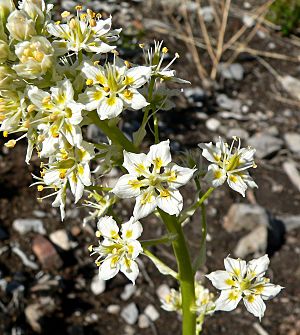Foothill deathcamas facts for kids
Quick facts for kids Foothill deathcamas |
|
|---|---|
 |
|
| Near Robbers Roost, Spring Mountains, southern Nevada | |
| Scientific classification | |
| Genus: |
Toxicoscordion
|
| Species: |
paniculatum
|
| Synonyms | |
|
|
Toxicoscordion paniculatum is a type of flowering plant. It is often called foothill deathcamas or sand-corn. This plant grows in many parts of the western United States. You can find it especially in the mountains and deserts of the Great Basin region. This area is west of the Rocky Mountains. It likes different places to grow, such as sagebrush plains, grasslands, and forests.
Contents
What is Foothill Deathcamas?
Toxicoscordion paniculatum is a wild plant that lives for many years. It grows from a brown or black bulb (like an onion). This bulb can be up to 5 centimeters long and 3 centimeters wide. The stem of the plant can grow up to 70 centimeters tall. Its leaves are long and thin, reaching up to 50 centimeters in length. Most of the leaves grow at the bottom of the stem. There might be a few smaller leaves higher up.
Flowers and Fruit
The plant's flowers grow in a cluster called a panicle. This cluster can have up to 80 flowers. Most of these flowers have both male and female parts. Some flowers, especially at the ends of branches or near the bottom, are only male or cannot produce seeds.
Each flower has six petal-like parts called tepals. The three inner tepals are a bit bigger than the outer ones. They are about 3 to 6 millimeters long. The tepals are a creamy color. Each one has a yellowish-green spot at its base. After the flowers, the plant produces a fruit. This fruit is a capsule, about 1 or 2 centimeters long.
Where Foothill Deathcamas Grows
This plant is common in the western United States. It thrives in various environments. You can find it in dry areas like sagebrush plateaus. It also grows in open grasslands. Forests and woodlands are other places where it can be found. Its wide distribution shows how adaptable it is to different conditions.
Safety Information
It is important to know that this plant is toxic. This means it can be harmful if eaten. Animals like livestock usually avoid eating it. This is because it does not taste good to them. However, there have been rare cases where people got sick from eating the bulbs. It is always best not to eat wild plants unless you are absolutely sure they are safe.
See also
 In Spanish: Toxicoscordion paniculatum para niños
In Spanish: Toxicoscordion paniculatum para niños

